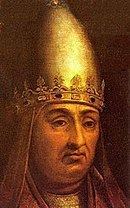Dean Gerardo Bianchi Dates 23 Dec 1294 – 24 Dec 1294 Protodeacon Matteo Rosso Orsini | Ballots 1 Camerlengo Tommaso d'Ocra Protopriest Pope Boniface VIII | |
 | ||
Location Castel Nuovo, Naples, Italy Other Instances Papal conclave - 1799–1800, Papal conclave - 1774–75, Papal conclave - 1769, Papal conclave - 1758, Papal conclave - 1740 | ||
The papal conclave of December 23–24, 1294 was convoked in Naples after the resignation of Pope Celestine V on 13 December 1294. Celestine V had only months earlier restored the Constitution Ubi periculum of Pope Gregory X, which had been suspended by Pope Adrian V in July 1276. From that time every papal election has been a papal conclave. It is the first papal conclave held during the lifetime of the preceding pontiff, the second such occurrence taking place in 2013 following the resignation of Pope Benedict XVI.
Contents
Abdication of Celestine V
Celestine V, founder of the Order of Celestines, widely esteemed and venerated for his holiness, was elected to the papacy on July 7, 1294, as a compromise choice after an over two-years long sede vacante. It quickly became clear that this saintly eremite was wholly incompetent and unsuited for a job as pope. Admitting his own incompetence soon after his election, Celestine expressed the wish to abdicate and return to his solitary cave in the Abruzzi Mountains. However, before doing so he issued two bulls. The first bull established the regulations concerning the abdication of a pope. The second bull (Quia in futurum, September 28, 1294) restored the constitution Ubi periculum, which established the papal conclave; the constitution had been suspended by Pope Adrian V in July 1276. During his short papacy, he also created 13 new cardinals. Eventually, on December 13, 1294, Celestine V abdicated the papacy at Naples, three days after confirming the restoration of the institution of the papal conclave.
It has been widely stated that the alleged great influence of the ambitious Cardinal Benedetto Caetani and the pressure he applied on Celestine V were important factors in Celestine's decision to abdicate, but it seems nearly as certain that it was an entirely voluntarily step of the Pope, with the role of Caetani limited to participation in the solution of the legal problems connected with the resignation of a pope. In particular, there were doubts whether a pope could resign at all, and who would be authorized to accept such a resignation.
List of participants
All 22 living cardinals participated in the conclave; 12 of them were created by Celestine V, five by Nicholas IV, two by Nicholas III, one by Urban IV and one by Honorius IV: Hugh Aycelin, also known as Hughes of Billom, of the French province of the Dominican Order, former lector at the studium of Santa Sabina in Rome, was made Cardinal-Bishop of the suburbicarian see of Ostia in 1294; as Bishop of Ostia he had the right to ordain and consecrate the new bishop of Rome, Pope Boniface VIII. The consecration and coronation took place on 23 January 1295.
Election of Pope Boniface VIII
On December 23, 1294, the cardinals assembled in the Castel Nuovo at Naples for the election of the successor of Celestine V. On the next day, Christmas Eve, Cardinal Benedetto Caetani received the required two-thirds majority and took the name of Boniface VIII. Caetani's nephew, who was an eyewitness, says that Caetani was elected after one scrutiny and an accessio: scrutinio accessioneque eligitur. Soon after his election he returned to Rome, where on January 23, 1295, he was consecrated to the episcopate by Cardinal Hugh Aycelin of Ostia, and crowned by Matteo Rosso Orsini, who was prior Diaconorum of the Sacred College.
